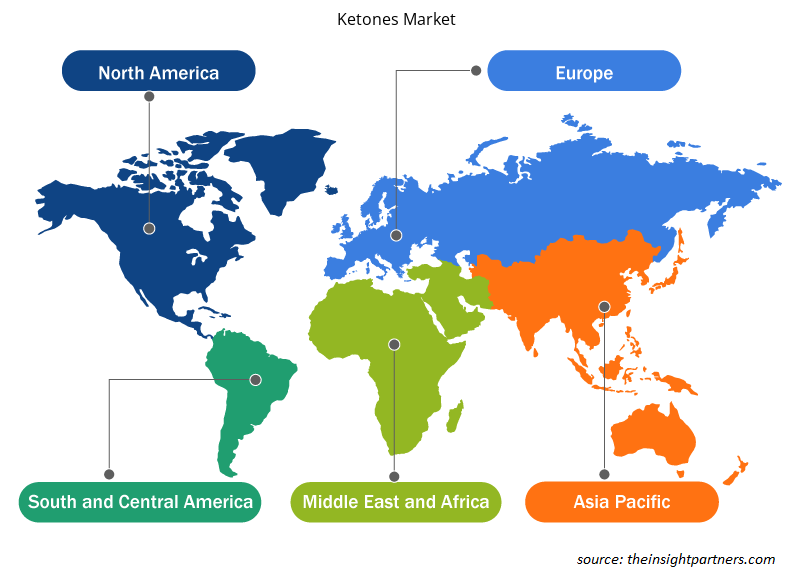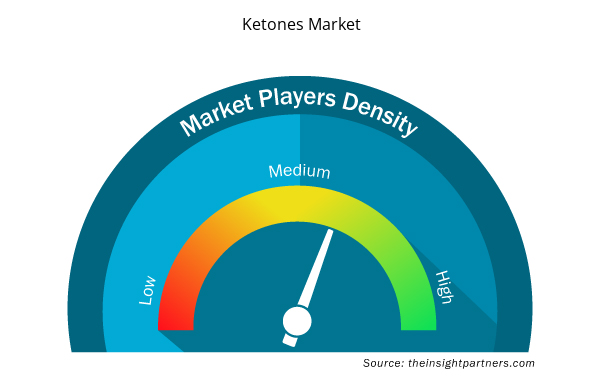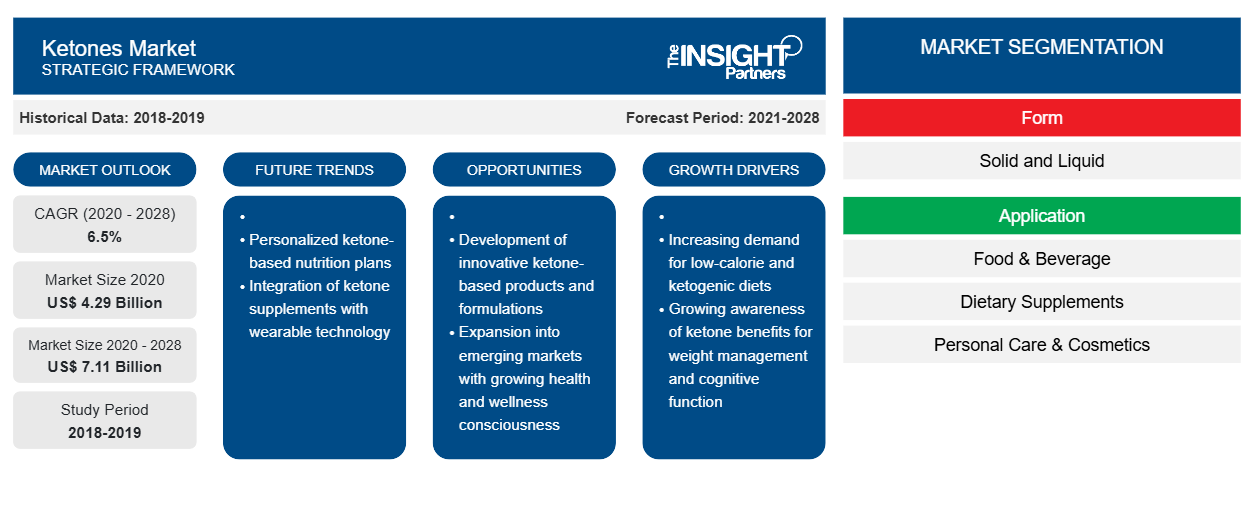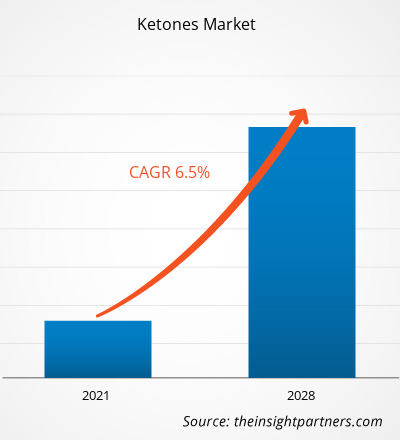[研究报告] 2020 年酮市场价值为 42.865 亿美元,预计到 2028 年将达到 71.065 亿美元;预计2021 年至 2028 年的复合年增长率为 6.5%。
酮类,例如丙酮、甲基乙基酮和二异丁基酮,被广泛用作工业溶剂和化学中间体,用于制造涂料、粘合剂、油漆、除漆剂、橡胶、塑料和药品。此外,外源酮还用于膳食补充剂。它们通常由酮盐(也称为β-羟基丁酸酯或BHB)和酮酯组成。
2020 年,亚太地区占据全球酮类市场的最大份额,预计在预测期内将实现最高的复合年增长率。对健康有益补充剂的需求增加是推动亚太地区市场增长的关键因素之一。由于人们忙碌的生活方式和对健康的担忧而改变的饮食习惯也推动了该地区酮类补充剂市场的增长。此外,根据国际可持续发展研究所的数据,亚太地区的化学行业占世界化学产量的 45% 以上,占全球化学工作岗位的 69% 以上。在化学工业中,酮被广泛用作溶剂和催化剂。因此,预计亚太地区成熟的化学工业将在未来一段时间内推动酮类市场的增长。
定制此报告以满足您的需求
您可以免费定制任何报告,包括本报告的部分内容、国家级分析、Excel 数据包,以及为初创企业和大学提供优惠和折扣
- 获取此报告的关键市场趋势。这个免费样品将包括数据分析,从市场趋势到估计和预测。
COVID-19 疫情对酮类市场的影响
由于多种因素,例如不同地区的长期封锁、对国际贸易的限制、制造单位的关闭、旅行禁令、供应链瓦解以及原材料供应短缺,COVID-19 疫情在销售和运营方面对各行各业产生了巨大影响。由于 COVID-19 疫情的爆发,食品饮料和化学工业是遭受严重破坏的重要行业之一,例如供应链限制和生产工厂关闭。北美、欧洲和亚太等主要地区的各种工厂和工厂的关闭阻碍了全球供应链、制造活动、交付计划和各种产品销售。所有这些因素都对化学和食品饮料行业产生了负面影响。酮通常用作化学工业中的溶剂、化学中间体和催化剂。油漆和涂料、粘合剂、印刷油墨和类似行业对它们的需求也很大。此外,它们还用作电镀行业的冷清洗溶剂、蒸汽脱脂溶剂和实验室化学品。酮还用于生产膳食补充剂、蛋白质奶昔和粉末以及药品。由于无限期封锁和临时隔离,从供应商采购原材料的中断以及制造基地的暂时关闭,在大流行期间抑制了市场的增长。然而,大流行在消费者中引发了对健康生活的需求。因此,消费者将注意力转向个人健康和营养饮食。因此,在大流行期间,对体重管理产品和酮补充剂的需求激增,直接推动了酮市场的发展。由于许多商店关闭,2020 年第一季度的销售缓慢。然而,随着先前实施的限制在各个地方得到放松,企业正在取得进展。此外,各国政府推出 COVID-19 疫苗进一步缓解了这种情况,导致全球商业活动的增加。食品和饮料加工行业正在通过开设生产部门并以一半的产能开始运营来弥补损失。这些因素预计将在预测期内推动市场增长。
市场洞察
各行业需求不断增长
酮是一种用途广泛的有机化合物,在各个行业中都有广泛的应用。丙酮、甲基乙基酮、甲基异丁基酮和二异丁基酮是重要的酮类化合物,常用于制造树脂、塑料、油漆和清漆、清漆、涂料、橡胶产品和其他工业产品。丙酮用于指甲油去除剂。在纺织行业中,它通常用于脱脂羊毛和脱胶丝绸。丙酮通常用作制造用于汽车和家具涂饰的漆的溶剂。它还可用于降低漆溶液的粘度。油漆和涂料行业占甲基乙基酮 (MEK) 产品需求的一半以上,因为这些材料可用于生产低粘度溶液而不会损害其薄膜属性。汽车、电器和家具行业都使用这些漆。漆是极好的表面涂层溶剂,是制造高固体、低排放涂层的必备溶剂。MEK 还用于生产聚合物和纺织品,以及印刷油墨、粘合剂、杀虫剂和橡胶基工业水泥。酮在食品饮料、制药和营养品行业中有着广泛的应用,它们用于制造补充剂、能量饮料、即饮 (RTD) 奶昔和奶昔粉等产品。酮基食品和补充剂有助于减肥,因为它们会触发体内脂肪的消耗。此外,酮作为油脂提取中的分馏剂越来越受欢迎,而且由于它们具有杀死细菌的能力,对这些化合物用于消毒医疗设备的需求不断增加,预计将在预测期内进一步推动市场增长。酮还因其宜人的气味而用于制造个人护理和化妆品。此外,它们还被用作各种医药产品和化学制造厂的化学中间体。因此,汽车、油漆和涂料、粘合剂、树脂制造、食品和饮料、药品和保健品以及个人护理和化妆品等各个行业对酮的需求不断增长,促进了酮市场的增长。
表单洞察
根据形态,酮市场分为固体和液体。2020 年液体部分占据了更大的市场份额,预计固体部分在预测期内将在市场上实现更高的复合年增长率。液体酮被用作涂料、粘合剂、印刷油墨、化学中间体、香水、清漆、脱漆剂、润滑剂、塑料和树脂等产品的溶剂和催化剂。丙酮、二异丁基酮、甲基乙基酮、甲基异丁烯酮等是市场上最常见的液体酮。液体酮以其独特的宜人气味而闻名。酮酯以液态形式用于膳食补充剂。化学制造公司对液体酮的需求不断增长是液体市场增长的主要贡献者。
应用程序洞察
根据应用,酮市场细分为食品和饮料、膳食补充剂、个人护理和化妆品等。其他应用领域在 2020 年占据了最大的市场份额,预计膳食补充剂领域在预测期内将在市场上实现最高的复合年增长率。酮的其他应用是化学和工业应用。甲基乙基酮、甲基异丁基酮、二异丁基酮和丙酮等酮是化学工业中广泛使用的化学中间体。丙酮被广泛用作生产丙烯酸塑料、聚碳酸酯和环氧树脂的化学中间体。此外,二异丁基酮被用作合成二异丁基甲醇的化学中间体。此外,甲基乙基酮被用作某些药品制造的化学中间体。丙烯酸塑料和环氧树脂广泛用于汽车和标牌应用。二异丁基甲醇用于合成过氧化氢、漆、虫胶、印刷油墨、氯乙烯-醋酸乙烯树脂、尿素-三聚氰胺树脂和醇酸树脂。酮用作油漆和涂料、粘合剂、汽车涂装、橡胶、纺织品、清漆、印刷油墨等的工业溶剂。在涂料行业,它们被广泛用作硝化纤维素和其他纤维素酯、树脂和氯乙烯-醋酸乙烯酯生产的溶剂。这些溶剂可用作活性溶剂或稀释剂,并且经常与其他溶剂一起使用。甲基乙基酮通常用作橡胶制造中的溶剂。此外,酮还用作油脂提取中的分馏剂。它们用于对医疗设备进行消毒,例如手术器械、皮下注射针、注射器和牙科器械。
在酮类市场运营的少数参与者包括 Compound Solutions Inc.;Aurochemicals;Taj Pharmaceuticals Chemicals;Orchid Chemical Supplies Ltd;Hunan NutraMax Inc.;HEALTH SOURCES NUTRITION CO., LTD.;Advanced Biotech;Eastman Chemical Company;Royal Dutch Shell plc.;和 SABIC。
酮类市场区域洞察
Insight Partners 的分析师已详细解释了预测期内影响酮市场的区域趋势和因素。本节还讨论了北美、欧洲、亚太地区、中东和非洲以及南美和中美洲的酮市场细分和地理位置。

- 获取酮市场的区域特定数据
酮市场报告范围
| 报告属性 | 细节 |
|---|---|
| 2020 年市场规模 | 42.9亿美元 |
| 2028 年市场规模 | 71.1亿美元 |
| 全球复合年增长率(2020 - 2028) | 6.5% |
| 史料 | 2018-2019 |
| 预测期 | 2021-2028 |
| 涵盖的领域 | 按形式
|
| 覆盖地区和国家 | 北美
|
| 市场领导者和主要公司简介 |
|
酮类市场参与者密度:了解其对业务动态的影响
酮类市场正在快速增长,这得益于终端用户需求的不断增长,而这些需求又源于消费者偏好的不断变化、技术进步以及对产品优势的认识不断提高等因素。随着需求的增加,企业正在扩大其产品范围,进行创新以满足消费者的需求,并利用新兴趋势,从而进一步推动市场增长。
市场参与者密度是指在特定市场或行业内运营的企业或公司的分布情况。它表明在给定市场空间中,相对于其规模或总市场价值,有多少竞争对手(市场参与者)存在。
在酮市场运营的主要公司有:
- 复合解决方案公司
- 石油化工
- 泰姬制药化工公司
- 兰花化工供应有限公司
- 湖南纽特麦克股份有限公司
免责声明:上面列出的公司没有按照任何特定顺序排列。

- 获取酮市场顶级关键参与者概述
报告亮点
- 酮类市场不断发展的行业趋势,帮助参与者制定有效的长期战略
- 发达市场和发展中市场采用的业务增长战略
- 2019 年至 2028 年酮类市场定量分析
- 全球酮类需求量估计
- 波特的五力分析说明了行业中买家和供应商的效力
- 了解竞争市场状况的最新发展
- 市场趋势和前景以及推动和抑制酮市场增长的因素
- 通过强调支撑商业利益的市场策略来协助决策过程,从而促进市场增长
- 不同节点酮类产品的市场规模
- 市场的详细概述和细分,以及酮类行业的动态
- 各地区酮类市场规模及增长潜力
酮类市场 – 按形式分类
- 坚硬的
- 液体
酮市场——按应用分类
- 食品和饮料
- 膳食补充剂
- 个人护理及化妆品
- 其他的
公司简介
- 复合解决方案公司
- 石油化工
- 泰姬制药化工公司
- 兰花化工供应有限公司
- 湖南纽特麦克股份有限公司
- 健康之源营养有限公司
- 先进生物技术
- 伊士曼化学公司
- 荷兰皇家壳牌有限公司
- 沙特基础工业公司
- 历史分析(2 年)、基准年、预测(7 年)及复合年增长率
- PEST 和 SWOT 分析
- 市场规模价值/数量 - 全球、区域、国家
- 行业和竞争格局
- Excel 数据集


- Cosmetic Bioactive Ingredients Market
- Electronic Toll Collection System Market
- Influenza Vaccines Market
- Predictive Maintenance Market
- Microcatheters Market
- Europe Industrial Chillers Market
- Bathroom Vanities Market
- Electronic Data Interchange Market
- Nuclear Decommissioning Services Market
- Fish Protein Hydrolysate Market

Report Coverage
Revenue forecast, Company Analysis, Industry landscape, Growth factors, and Trends

Segment Covered
This text is related
to segments covered.

Regional Scope
North America, Europe, Asia Pacific, Middle East & Africa, South & Central America

Country Scope
This text is related
to country scope.
常见问题
Rising popularity of ketogenic supplements is one of the key drivers for the growth of the global ketones market. Ketogenic supplements are a part of weight-loss medication that encourages human body to derive energy by burning body fats instead of carbohydrates, mainly triggered by the unavailability of the later for catabolism. Exogenous ketones are included in KETO diet supplements and can help in losing weight faster, gain energy, and enhance mental clarity. Exogenous ketone supplements benefit consumers by facilitating athletic performance improvement, efficient weight reduction, cancer prevention, cognitive improvement, and anti-inflammatory characteristics and skin health enhancement. Exogenous ketone supplements are of three types: ketone salts, ketone esters, and medium chain triglycerides (MCTs). These supplements are available in the form of pills, tablets, and powders. Ketogenic supplements, such as ketone salts, are added to RTD shakes, shake powders, and energy drinks. These supplements also prevent the KETO flu, which is generally caused by following ketogenic diet. This factor is also driving the popularity of ketogenic supplements among the fitness and sports enthusiast. Thus, the increasing popularity of ketogenic supplements is significantly driving the growth of ketones market.
North America is anticipated to hold the second largest share for the ketones market during the projection period. The US, Canada, and Mexico are among the major economies in North America, and the US dominates the market in this region. A rise in the prevalence of obesity in North America is anticipated to drive demand for ketone supplements and food products for shredding weight. This population is generating high demand for low-carb and high-protein food products and supplements with natural ingredients. Consumer focus on improving their diet habits is a critical trend in the food & beverages industry. Amid the COVID-19 pandemic, a large percentage of consumers in this region have adopted healthier food habits. Raspberry ketone is extracted from red raspberries as well as kiwifruit, peaches, grapes, apples, other berries and various vegetables, is believed to address the issue of obesity. Besides, the synthetically produced version of raspberry ketone is commonly used in cosmetics and personal care products.
On the basis of application, the others segment led the global ketones market in 2020. The others segment includes chemical and industrial applications. Ketones such as methyl ethyl ketone, methyl isobutyl ketone, di-isobutyl ketone, and acetone are widely used chemical intermediates in the chemicals industry. Acetone is widely used as a chemical intermediate in the production of acrylic plastics, polycarbonates, and epoxy resins. Further, ketones are used as industrial solvents in the manufacturing of paints and coatings, adhesives, automotive finishes, rubbers, textiles, varnishes, printing inks, etc. In the coatings industry, they are widely used as solvents in the production of nitrocellulose and other cellulose esters, resins, and vinyl chloride-vinyl acetate. These solvents can be employed as active solvents or diluents, and they are frequently used in conjunction with other solvents. Methyl ethyl ketones are commonly used as a solvent in rubber manufacturing.
The major players operating in the global ketones market are Compound Solutions Inc.; Aurochemicals; Taj Pharmaceuticals Chemicals; Orchid Chemical Supplies Ltd; Hunan NutraMax Inc.; HEALTH SOURCES NUTRITION CO., LTD.; Advanced Biotech; Eastman Chemical Company; Royal Dutch Shell plc.; and SABIC.
During the forecast period, Asia Pacific is anticipated to account for the largest share in the global ketones market. One of the key drivers of ketones' growth in Asia-Pacific is the increased demand for health-beneficial supplements. Changing eating habits of people because of their hectic lifestyles and health concerns, boosting the expansion of the ketone supplement market in the area. Moreover, in the chemical industry, ketones are extensively utilized as solvents and catalysts. The well-established chemicals industry in Asia-Pacific is expected to further boost the growth of ketones market in the forthcoming period.
Based on form, the liquid segment is anticipated to account for the largest share in the global ketones market. The growth is attributed to the use of liquid ketones as solvents and catalysts for manufacturing multiple products such as coatings, adhesives, printing inks, chemical intermediaries, perfumes, lacquers, paint removers, lubricating agents, plastics and resins, among others. The most common liquid ketones include acetone, diisobutyl ketone, methyl ethyl ketone, and methyl isobutylene ketone, among others. Moreover, liquid ketones are known for their distinctive pleasant odor. The growing demand for liquid ketones from chemical manufacturers is primarily driving the market growth.
Trends and growth analysis reports related to Food and Beverages : READ MORE..
The List of Companies - Ketones Market
- Compound Solutions Inc.
- Aurochemicals
- Taj Pharmaceuticals Chemicals
- Orchid Chemical Supplies Ltd
- Hunan NutraMax Inc.
- Health Sources Nutrition Co., Ltd.
- Advanced Biotech
- Eastman Chemical Company
- Royal Dutch Shell plc.
- SABIC
The Insight Partners performs research in 4 major stages: Data Collection & Secondary Research, Primary Research, Data Analysis and Data Triangulation & Final Review.
- Data Collection and Secondary Research:
As a market research and consulting firm operating from a decade, we have published and advised several client across the globe. First step for any study will start with an assessment of currently available data and insights from existing reports. Further, historical and current market information is collected from Investor Presentations, Annual Reports, SEC Filings, etc., and other information related to company’s performance and market positioning are gathered from Paid Databases (Factiva, Hoovers, and Reuters) and various other publications available in public domain.
Several associations trade associates, technical forums, institutes, societies and organization are accessed to gain technical as well as market related insights through their publications such as research papers, blogs and press releases related to the studies are referred to get cues about the market. Further, white papers, journals, magazines, and other news articles published in last 3 years are scrutinized and analyzed to understand the current market trends.
- Primary Research:
The primarily interview analysis comprise of data obtained from industry participants interview and answers to survey questions gathered by in-house primary team.
For primary research, interviews are conducted with industry experts/CEOs/Marketing Managers/VPs/Subject Matter Experts from both demand and supply side to get a 360-degree view of the market. The primary team conducts several interviews based on the complexity of the markets to understand the various market trends and dynamics which makes research more credible and precise.
A typical research interview fulfils the following functions:
- Provides first-hand information on the market size, market trends, growth trends, competitive landscape, and outlook
- Validates and strengthens in-house secondary research findings
- Develops the analysis team’s expertise and market understanding
Primary research involves email interactions and telephone interviews for each market, category, segment, and sub-segment across geographies. The participants who typically take part in such a process include, but are not limited to:
- Industry participants: VPs, business development managers, market intelligence managers and national sales managers
- Outside experts: Valuation experts, research analysts and key opinion leaders specializing in the electronics and semiconductor industry.
Below is the breakup of our primary respondents by company, designation, and region:

Once we receive the confirmation from primary research sources or primary respondents, we finalize the base year market estimation and forecast the data as per the macroeconomic and microeconomic factors assessed during data collection.
- Data Analysis:
Once data is validated through both secondary as well as primary respondents, we finalize the market estimations by hypothesis formulation and factor analysis at regional and country level.
- Macro-Economic Factor Analysis:
We analyse macroeconomic indicators such the gross domestic product (GDP), increase in the demand for goods and services across industries, technological advancement, regional economic growth, governmental policies, the influence of COVID-19, PEST analysis, and other aspects. This analysis aids in setting benchmarks for various nations/regions and approximating market splits. Additionally, the general trend of the aforementioned components aid in determining the market's development possibilities.
- Country Level Data:
Various factors that are especially aligned to the country are taken into account to determine the market size for a certain area and country, including the presence of vendors, such as headquarters and offices, the country's GDP, demand patterns, and industry growth. To comprehend the market dynamics for the nation, a number of growth variables, inhibitors, application areas, and current market trends are researched. The aforementioned elements aid in determining the country's overall market's growth potential.
- Company Profile:
The “Table of Contents” is formulated by listing and analyzing more than 25 - 30 companies operating in the market ecosystem across geographies. However, we profile only 10 companies as a standard practice in our syndicate reports. These 10 companies comprise leading, emerging, and regional players. Nonetheless, our analysis is not restricted to the 10 listed companies, we also analyze other companies present in the market to develop a holistic view and understand the prevailing trends. The “Company Profiles” section in the report covers key facts, business description, products & services, financial information, SWOT analysis, and key developments. The financial information presented is extracted from the annual reports and official documents of the publicly listed companies. Upon collecting the information for the sections of respective companies, we verify them via various primary sources and then compile the data in respective company profiles. The company level information helps us in deriving the base number as well as in forecasting the market size.
- Developing Base Number:
Aggregation of sales statistics (2020-2022) and macro-economic factor, and other secondary and primary research insights are utilized to arrive at base number and related market shares for 2022. The data gaps are identified in this step and relevant market data is analyzed, collected from paid primary interviews or databases. On finalizing the base year market size, forecasts are developed on the basis of macro-economic, industry and market growth factors and company level analysis.
- Data Triangulation and Final Review:
The market findings and base year market size calculations are validated from supply as well as demand side. Demand side validations are based on macro-economic factor analysis and benchmarks for respective regions and countries. In case of supply side validations, revenues of major companies are estimated (in case not available) based on industry benchmark, approximate number of employees, product portfolio, and primary interviews revenues are gathered. Further revenue from target product/service segment is assessed to avoid overshooting of market statistics. In case of heavy deviations between supply and demand side values, all thes steps are repeated to achieve synchronization.
We follow an iterative model, wherein we share our research findings with Subject Matter Experts (SME’s) and Key Opinion Leaders (KOLs) until consensus view of the market is not formulated – this model negates any drastic deviation in the opinions of experts. Only validated and universally acceptable research findings are quoted in our reports.
We have important check points that we use to validate our research findings – which we call – data triangulation, where we validate the information, we generate from secondary sources with primary interviews and then we re-validate with our internal data bases and Subject matter experts. This comprehensive model enables us to deliver high quality, reliable data in shortest possible time.


 获取此报告的免费样本
获取此报告的免费样本